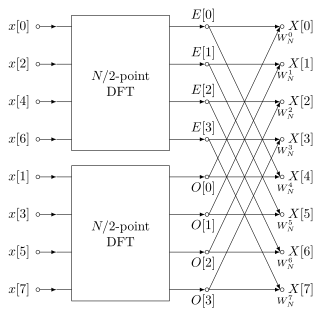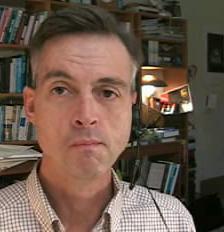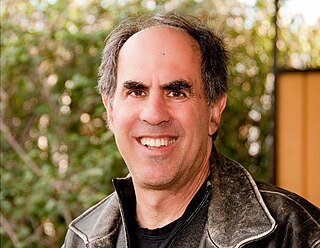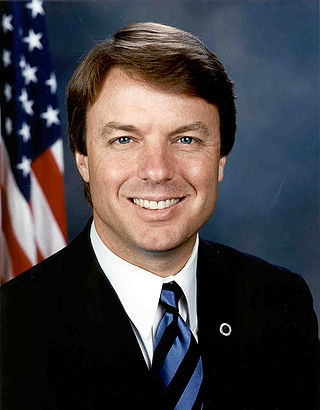
A fast Fourier transform (FFT) is an algorithm that computes the Discrete Fourier Transform (DFT) of a sequence, or its inverse (IDFT). Fourier analysis converts a signal from its original domain to a representation in the frequency domain and vice versa. The DFT is obtained by decomposing a sequence of values into components of different frequencies. This operation is useful in many fields, but computing it directly from the definition is often too slow to be practical. An FFT rapidly computes such transformations by factorizing the DFT matrix into a product of sparse factors. As a result, it manages to reduce the complexity of computing the DFT from , which arises if one simply applies the definition of DFT, to , where n is the data size. The difference in speed can be enormous, especially for long data sets where n may be in the thousands or millions. In the presence of round-off error, many FFT algorithms are much more accurate than evaluating the DFT definition directly or indirectly. There are many different FFT algorithms based on a wide range of published theories, from simple complex-number arithmetic to group theory and number theory.
A discrete cosine transform (DCT) expresses a finite sequence of data points in terms of a sum of cosine functions oscillating at different frequencies. The DCT, first proposed by Nasir Ahmed in 1972, is a widely used transformation technique in signal processing and data compression. It is used in most digital media, including digital images, digital video, digital audio, digital television, digital radio, and speech coding. DCTs are also important to numerous other applications in science and engineering, such as digital signal processing, telecommunication devices, reducing network bandwidth usage, and spectral methods for the numerical solution of partial differential equations.

The speed of sound is the distance travelled per unit of time by a sound wave as it propagates through an elastic medium. More simply, the speed of sound is how fast vibrations travel. At 20 °C (68 °F), the speed of sound in air is about 343 m/s, or 1 km in 2.91 s or one mile in 4.69 s. It depends strongly on temperature as well as the medium through which a sound wave is propagating. At 0 °C (32 °F), the speed of sound in air is about 331 m/s.
New media are communication technologies that enable or enhance interaction between users as well as interaction between users and content. In the middle of the 1990s, the phrase "new media" became widely used as part of a sales pitch for the influx of interactive CD-ROMs for entertainment and education. The new media technologies, sometimes known as Web 2.0, include a wide range of web-related communication tools such as blogs, wikis, online social networking, virtual worlds, and other social media platforms.

Robert Wright is an American author and journalist known for his wide-ranging interests in philosophy, society, science, history, politics, international relations, and religion. He has published five books: Three Scientists and Their Gods: Looking for Meaning in an Age of Information (1988), The Moral Animal (1994), Nonzero: The Logic of Human Destiny (1999), The Evolution of God (2009), and Why Buddhism is True (2017). Wright has taught at Princeton University and the University of Pennsylvania; more recently, in 2019 he was Visiting Professor of Science and Religion at Union Theological Seminary, New York.
In futures studies and the history of technology, accelerating change is the observed exponential nature of the rate of technological change in recent history, which may suggest faster and more profound change in the future and may or may not be accompanied by equally profound social and cultural change.
The slow movement is a cultural initiative that advocates for a reduction in the pace of modern life, encouraging individuals to embrace a more thoughtful and deliberate approach to their daily activities.

Bruce Feiler is an American writer and television personality. He is the author of 15 books, including The Council of Dads, a book that describes how he responded to a diagnosis of a rare cancer by asking a group of men to be present in the lives of his young daughters. The book was the subject of a TED Talk and inspired NBC drama series Council of Dads. His latest work explores the power of life stories. Drawing on interviews with Americans in all 50 states, he offers strategies for coping with life's unsettling times in his new book, Life Is In The Transitions. Bruce writes the "This Life" column in the Sunday New York Times and is also the writer/presenter of the PBS miniseries Walking the Bible and Sacred Journeys with Bruce Feiler (2014).
Time–space compression is an idea referring to the altering of the qualities of space–time and the relationship between space and time that is a consequence of the expansion of capital. It is rooted in Karl Marx's notion of the "annihilation of space by time" originally elaborated in the Grundrisse, and was later articulated by Marxist geographer David Harvey in his book The Condition of Postmodernity. A similar idea was proposed by Elmar Altvater in an article in PROKLA in 1987, translated into English as "Ecological and Economic Modalities of Time and Space" and published in Capitalism Nature Socialism in 1990.
The decisive event which established the discipline of information theory, and brought it to immediate worldwide attention, was the publication of Claude E. Shannon's classic paper "A Mathematical Theory of Communication" in the Bell System Technical Journal in July and October 1948.
In computing, computer performance is the amount of useful work accomplished by a computer system. Outside of specific contexts, computer performance is estimated in terms of accuracy, efficiency and speed of executing computer program instructions. When it comes to high computer performance, one or more of the following factors might be involved:

Robert Michael "Mickey" Kaus is an American journalist, pundit, and author, known for writing Kausfiles, a "mostly political" blog which was featured on Slate until 2010. Kaus is the author of The End of Equality and had previously worked as a journalist for Newsweek, The New Republic, and Washington Monthly, among other publications.

The 24-hour news cycle is the 24-hour investigation and reporting of news, concomitant with fast-paced lifestyles. The vast news resources available in recent decades have increased competition for audience and advertiser attention, prompting media providers to deliver the latest news in the most compelling manner in order to remain ahead of competitors. Television, radio, print, online and mobile app news media all have many suppliers that want to be relevant to their audiences and deliver news first.

John Edwards is a former United States Senator from North Carolina and a Democratic Party vice-presidential and presidential candidate. In August 2008, Edwards admitted to an extramarital affair, which was initially reported in December 2007 by the National Enquirer but was given little attention outside the tabloid press and political blogosphere. The Enquirer cited claims from an anonymous source that Edwards had engaged in an affair with Rielle Hunter, a filmmaker hired to work for his 2008 presidential campaign, and that Hunter had given birth to a child from the relationship. ABC News reported that Andrew Young, a member of Edwards' campaign team, stated that Edwards asked him to, "Get a doctor to fake the DNA results ... and to steal a diaper from the baby so he could secretly do a DNA test to find out if this [was] indeed his child."
JournoList was a private Google Groups forum for discussing politics and the news media with 400 left-leaning journalists, academics and others. Ezra Klein created the online forum in February 2007 while blogging at The American Prospect and shut it down on June 25, 2010 amid wider public exposure. Journalists later pointed out various off-color statements made by members of the list denigrating conservatives. Others defended such statements as being taken out of context or simply a matter of private candor.

An Army of Davids: How Markets and Technology Empower Ordinary People to Beat Big Media, Big Government, and Other Goliaths is a non-fiction book by Glenn Reynolds, a law professor at the University of Tennessee also known as the blogger 'Instapundit'. The book looks at modern American society through the lens of individuals versus social institutions, and Reynolds concludes that technological change has allowed more freedom of action for people in contrast to the 'big' establishment organizations that used to function as gatekeepers. Thus, he argues that the balance of power between individuals and institutions is "flatting out", which involves numerous decentralized networks rising up. Nelson Current, an arm of Thomas Nelson, Inc., published the book on March 7, 2006.
Fashion forecasting began in France during the reign of Louis XIV. It started as a way of communicating about fashion and slowly transformed into a way to become ahead of the times in the fashion industry. Fashion forecasting predicts the moods of society and consumers, along with their behavior and buying habits and bases what they may release in the coming future off of the forecast. Fashion trends tend to repeat themselves every 20 years, and fashion forecasting predicts what other trends might begin with the rotation of fashion as well. Fashion forecasting can be used for many different reasons, the main reason being staying on top of current trends and knowing what your consumer is going to want in the future. This method helps fashion brands know what to expect and what to begin producing ahead of time. Top name brands and high end companies such as Vogue and Gucci even use this method to help their designers become even more informed on what is to come in the fashion industry.

The Information: A History, a Theory, a Flood is a book by science history writer James Gleick, published in March 2011, which covers the genesis of the current Information Age. It was on The New York Times best-seller list for three weeks following its debut.
Pace of innovation is the speed at which technological innovation or advancement is occurring, with the most apparent instances being too slow or too rapid. Both these rates of innovation are extreme and therefore have effects on the people that get to use this technology.
Gerald Paul "Jerry" Hirshberg was an American automotive designer, industrial designer, musician and painter.








